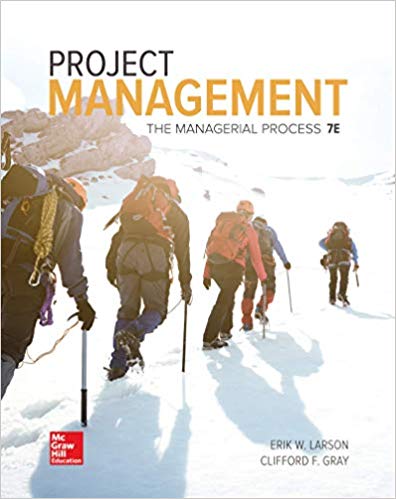Answered step by step
Verified Expert Solution
Question
1 Approved Answer
Give to me your managerial perspective and opinion related to this case study ? As soon as possible I (the casewriter) arrived early at 7:00
Give to me your managerial perspective and opinion related to this case study ? 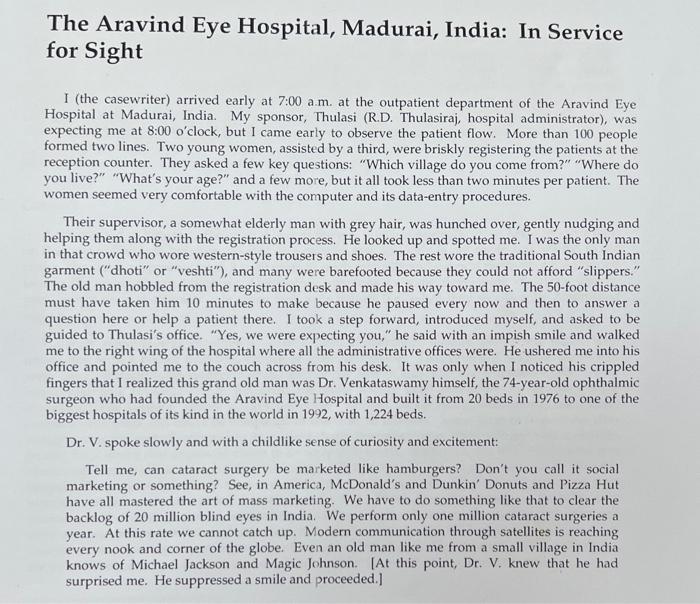

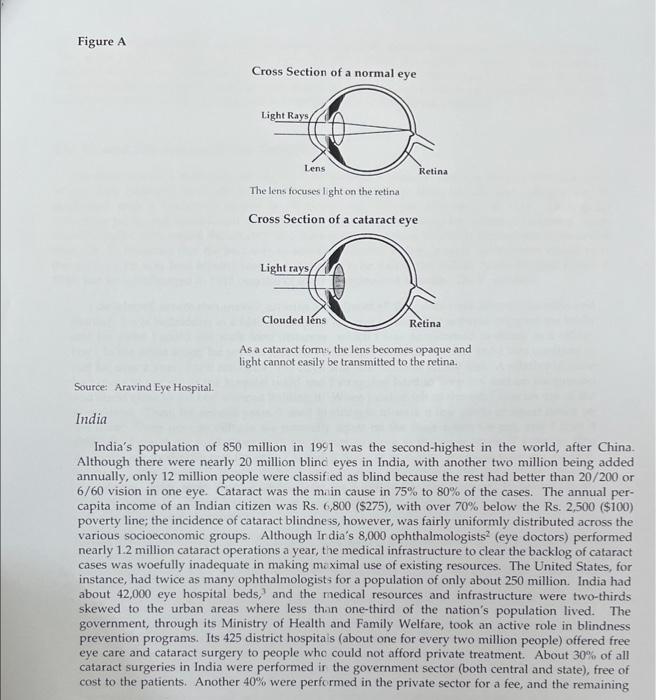
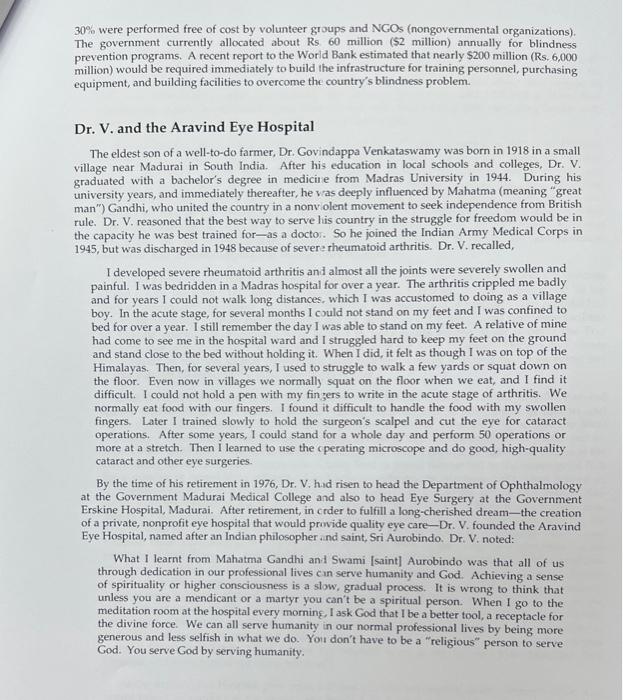
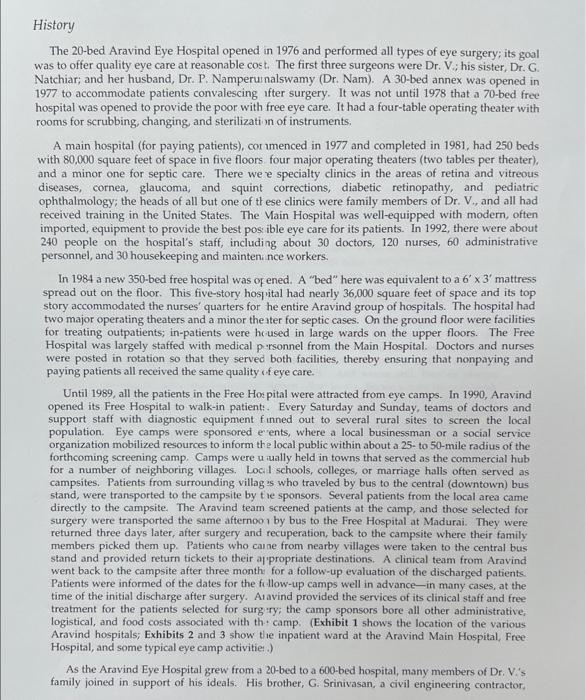
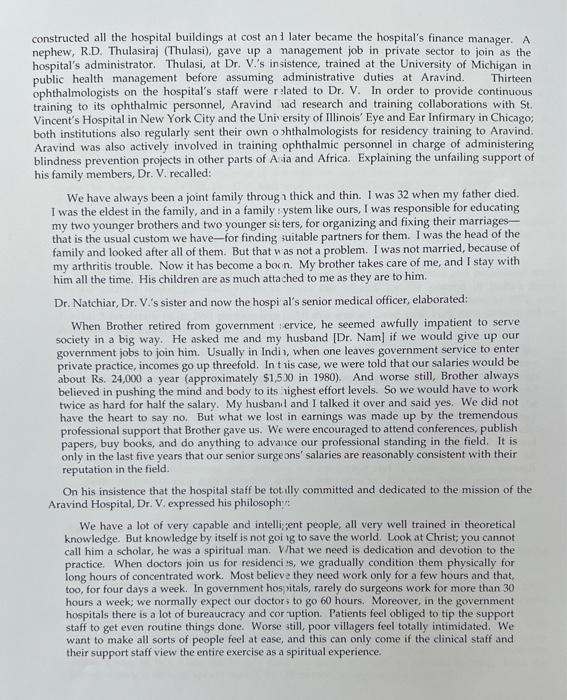
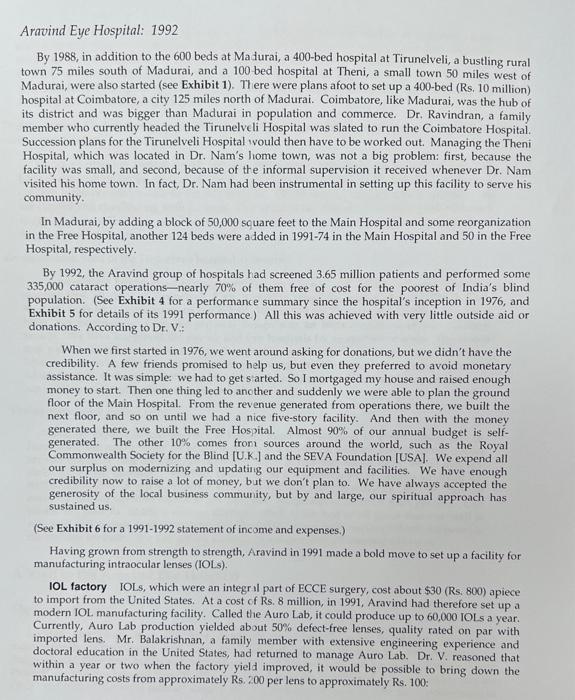
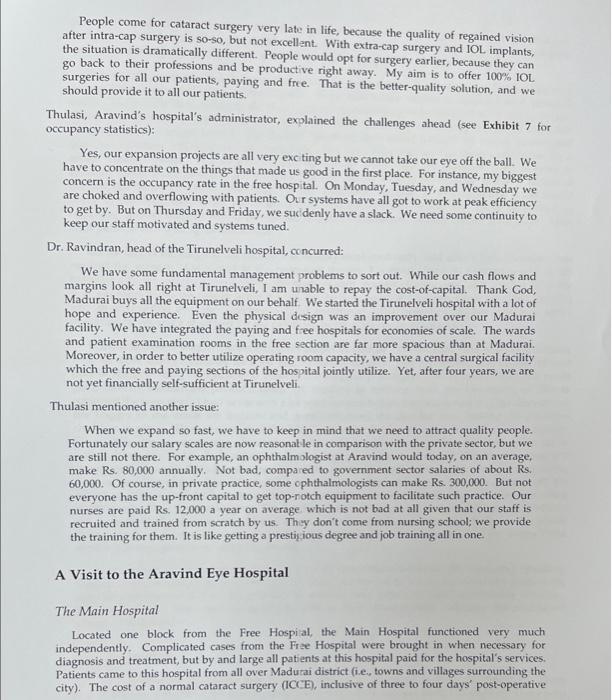
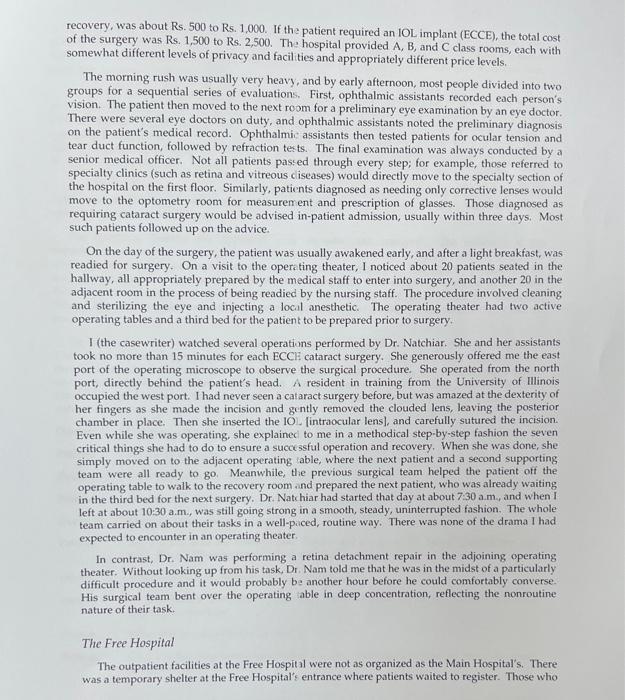
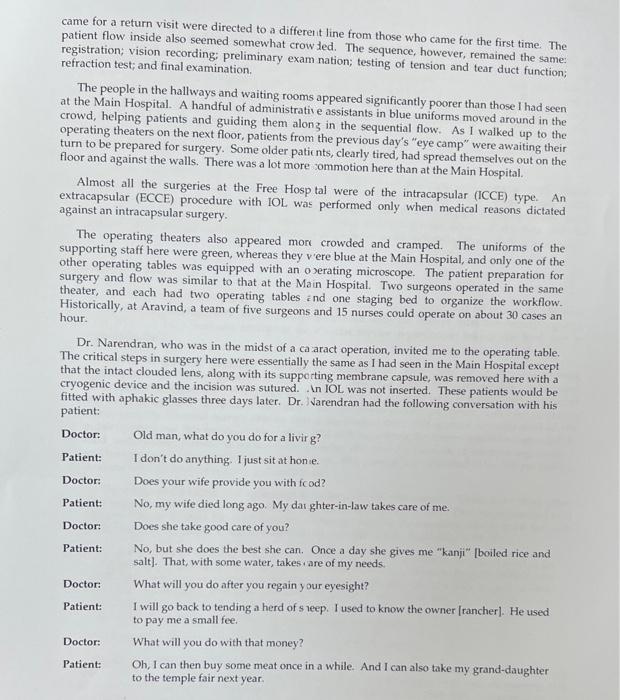
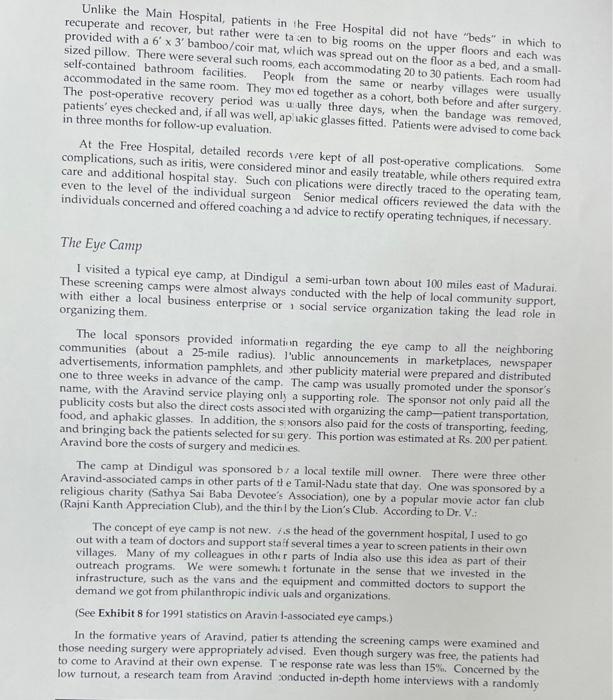
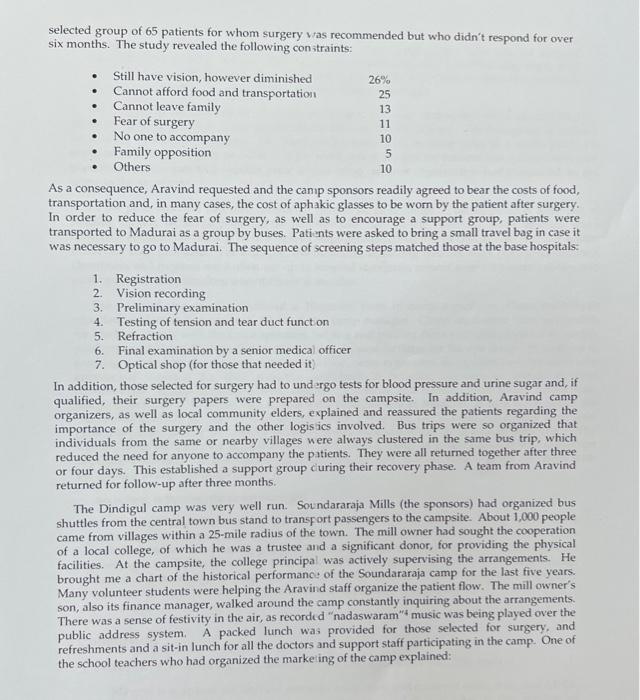
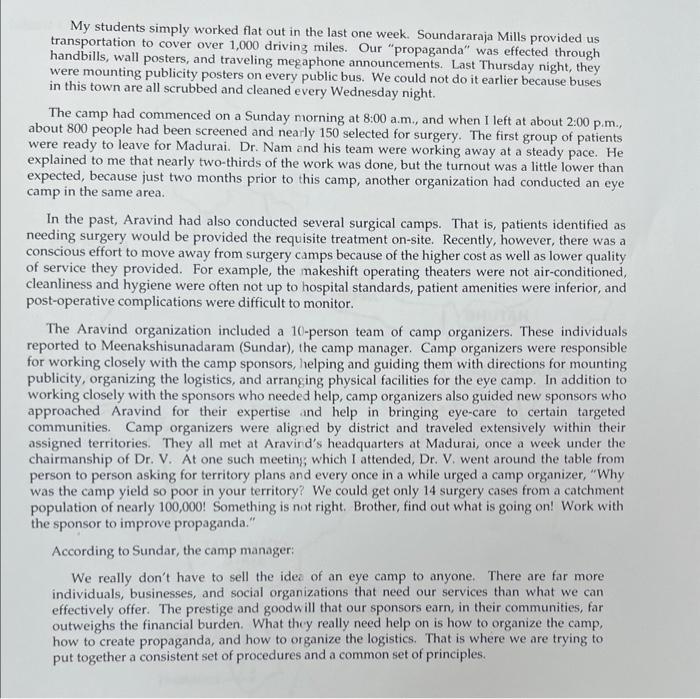
I (the casewriter) arrived early at 7:00 a m. at the outpatient department of the Aravind Eye Hospital at Madurai, India. My sponsor, Thulasi (R.D. Thulasiraj, hospital administrator), was expecting me at 8:00 o'clock, but I came early to observe the patient flow. More than 100 people formed two lines. Two young women, assisted by a third, were briskly registering the patients at the reception counter. They asked a few key questions: "Which village do you come from?" "Where do you live?" "What's your age?" and a few more, but it all took less than two minutes per patient. The women seemed very comfortable with the computer and its data-entry procedures. Their supervisor, a somewhat elderly man with grey hair, was hunched over, gently nudging and helping them along with the registration process. He looked up and spotted me. I was the only man in that crowd who wore western-style trousers and shoes. The rest wore the traditional South Indian garment ("dhoti" or "veshti"), and many were barefooted because they could not afford "slippers." The old man hobbled from the registration desk and made his way toward me. The 50 -foot distance must have taken him 10 minutes to make because he paused every now and then to answer a question here or help a patient there. I took a step forward, introduced myself, and asked to be guided to Thulasi's office. "Yes, we were expecting you," he said with an impish smile and walked me to the right wing of the hospital where all the administrative offices were. He ushered me into his office and pointed me to the couch across from his desk. It was only when I noticed his crippled fingers that I realized this grand old man was Dr. Venkataswamy himself, the 74-year-old ophthalmic surgeon who had founded the Aravind Eye Hospital and built it from 20 beds in 1976 to one of the biggest hospitals of its kind in the world in 1992, with 1,224 beds. Dr. V. spoke slowly and with a childlike sense of curiosity and excitement: Tell me, can cataract surgery be marketed like hamburgers? Don't you call it social marketing or something? See, in America, McDonald's and Dunkin' Donuts and Pizza Hut have all mastered the art of mass marketing. We have to do something like that to clear the backlog of 20 million blind eyes in India. We perform only one million cataract surgeries a year. At this rate we cannot catch up. Modern communication through satellites is reaching every nook and corner of the globe. Even an old man like me from a small village in India knows of Michael Jackson and Magic Johnson. [At this point, Dr. V. knew that he had surprised me. He suppressed a smile and proceeded.] Why can't we bring eyesight to the masses of poor people in India, Asia, Africa, and all over the world? I would like to do that in my lifetime. How do you think we should do it? "I'm not sure," I responded, completely swept away and exhausted by the grand vision of this giant human being. But I don't think he wanted an answer that did not match his immense enthusiasm. He wanted a way to further his goal, not a real debate on whether the goal was feasible. The Blindness Problem As of 1992 , there were 30 million blind people in the world -6 million in Africa, 20 million in Asia, 2 million in Latin America, and the rest in Europe, the former Soviet Union, Oceania, and North America. The prevalence of blindness in most inclustrialized countries of Europe and North America varied between 0.15% to 0.25%, compared with blindness rates of nearly 1.5% for the developing countries in Africa, Asia, and Latin America. While age-related macular degeneration, diabetic retinopathy, and glaucoma were the dominant causes in developed countries, cataract was the major cause of blindness in the developing countries, accounting for nearly 75% of all cases in Asia. Of the several types of cataracts, more than 80% were age-related, generally occurring in people over 45 years (and increasing dramatically in the over-65 age group). Cataract As illustrated in Figure A, the natural lens of the eye, which is normally clear, helps to focus light on the retina. The lens becomes clouded in a cataract eye, and light is not easily transmitted to the retina. The clouding process takes 3 to 10 years to reach maturity and surgical removal of the clouded lens is the only proven treatment. Ophthalmic surgeons in some developing countries usually preferred to remove cataracts only when they were mature (i.e., when they significantly diminished sight.) Cataract removal was considered a fairly routine operation, usually performed under local anesthesia, with a higher than 95% chance of improved vision. Two principal surgical techniques were used: intracapsular surgery without intraocular lens (ICCE), and extracapsular surgery with intraocular lens (ECCE). ICCE remained the most widely used procedure in the developing countries. The surgery, almost always performed without an operating microscope, used fairly simple instruments and could be completed in less than 20 minutes. Some three to five weeks after surgery, after the eyeball returned to its original shape, the patient was fitted with aphakic spectacles (rather thick lenses that improved vision to an acceptable level). In contrast, the ECCE technique was always performed under an operating microscope. This surgery often required close to 30 minutes, because the surgeon left the posterior capsule intact when removing the natural lens, and then inserted a tiny transparent plastic intraocular lens (IOL) in the posterior chamber. Patients often therefore did not require corrective spectacles to restore vision. Moreover, the quality of the restored sight was near-natural and free of distortion or magnification. Unlike ICCE patients, ECCE patients usually experienced significant improvement in sight within days of the operation. ICCE patients, on the other hand, usually experienced gradual improvement over a three-to five-week period. Figure A Cross Section of a normal eye The lens focuses I ght on the retina Cross Section of a cataract eye As a cataract formi, the lens becomes opaque and light cannot easily be transmitted to the retina. Source: Aravind Eye Hospital. India India's population of 850 million in 1991 was the second-highest in the world, after China. Although there were nearly 20 million blinc eyes in India, with another two million being added annually, only 12 million people were classifed as blind because the rest had better than 20/200 or 6/60 vision in one eye. Cataract was the main cause in 75% to 80% of the cases. The annual percapita income of an Indian citizen was Rs. 6,800 (\$275), with over 70% below the Rs. 2,500($100) poverty line; the incidence of cataract blindness, however, was fairly uniformly distributed across the various socioeconomic groups. Although Ir dia's 8,000 ophthalmologists 2 (eye doctors) performed nearly 1.2 million cataract operations a year, the medical infrastructure to clear the backlog of cataract cases was woefully inadequate in making maximal use of existing resources. The United States, for instance, had twice as many ophthalmologists for a population of only about 250 million. India had about 42,000 eye hospital beds, 3 and the medical resources and infrastructure were two-thirds skewed to the urban areas where less than one-third of the nation's population lived. The government, through its Ministry of Health and Family Welfare, took an active role in blindness prevention programs. Its 425 district hospitals (about one for every two million people) offered free eye care and cataract surgery to people who could not afford private treatment. About 30% of all cataract surgeries in India were performed ir the government sector (both central and state), free of cost to the patients. Another 40% were performed in the private sector for a fee, and the remaining 30% were performed free of cost by volunteer groups and NGOs (nongovernmental organizations). The government currently allocated about Rs 60 million ( $2 million) annually for blindness prevention programs. A recent report to the Worid Bank estimated that nearly $200 million (Rs. 6,000 million) would be required immediately to build the infrastructure for training personnel, purchasing equipment, and building facilities to overcome the country's blindness problem. Dr. V. and the Aravind Eye Hospital The eldest son of a well-to-do farmer, Dr. Govindappa Venkataswamy was born in 1918 in a small village near Madurai in South India. After his education in local schools and colleges, Dr. V. graduated with a bachelor's degree in medicile from Madras University in 1944. During his university years, and immediately thereafter, he vas deeply influenced by Mahatma (meaning "great man") Gandhi, who united the country in a nonviolent movement to seek independence from British rule. Dr. V, reasoned that the best way to serve lis country in the struggle for freedom would be in the capacity he was best trained for-as a doctor. So he joined the Indian Army Medical Corps in 1945 , but was discharged in 1948 because of severe rheumatoid arthritis. Dr. V. recalled, I developed severe rheumatoid arthritis and almost all the joints were severely swollen and painful. I was bedridden in a Madras hospital for over a year. The arthritis crippled me badly and for years I could not walk long distances, which I was accustomed to doing as a village boy. In the acute stage, for several months I could not stand on my feet and I was confined to bed for over a year. I still remember the day I was able to stand on my feet. A relative of mine had come to see me in the hospital ward and I struggled hard to keep my feet on the ground and stand close to the bed without holding it. When I did, it felt as though I was on top of the Himalayas. Then, for several years, I used to struggle to walk a few yards or squat down on the floor. Even now in villages we normally squat on the floor when we eat, and I find it difficult. 1 could not hold a pen with my fingers to write in the acute stage of arthritis. We normally eat food with our fingers. I found it difficult to handle the food with my swollen fingers. Later I trained slowly to hold the surgeon's scalpel and cut the eye for cataract operations. After some years, 1 could stand for a whole day and perform 50 operations or more at a stretch. Then I learned to use the cperating microscope and do good, high-quality cataract and other eye surgeries. By the time of his retirement in 1976, Dr. V. had risen to head the Department of Ophthalmology at the Government Madurai Medical College and also to head Eye Surgery at the Government Erskine Hospital, Madurai. After retirement, in crder to fulfill a long-cherished dream-the creation of a private, nonprofit eye hospital that would provide quality eye care-Dr. V. founded the Aravind Eye Hospital, named after an Indian philosopher and saint, Sri Aurobindo. Dr. V. noted: What I learnt from Mahatma Gandhi and Swami [saint] Aurobindo was that all of us through dedication in our professional lives cin serve humanity and God. Achieving a sense of spirituality or higher consciousness is a slow, gradual process. It is wrong to think that unless you are a mendicant or a martyr you can't be a spiritual person. When I go to the meditation room at the hospital every morning, I ask God that I be a better tool, a receptacle for the divine force. We can all serve humanity in our normal professional lives by being more generous and less selfish in what we do. You don't have to be a "religious" person to serve God. You serve God by serving humanity. History The 20-bed Aravind Eye Hospital opened in 1976 and performed all types of eye surgery; its goal was to offer quality eye care at reasonable cost. The first three surgeons were Dr. V;; his sister, Dr. G. Natchiar; and her husband, Dr. P. Namperumalswamy (Dr. Nam). A 30-bed annex was opened in 1977 to accommodate patients convalescing ifter surgery. It was not until 1978 that a 70 -bed free hospital was opened to provide the poor with free eye care. It had a four-table operating theater with rooms for scrubbing, changing, and sterilization of instruments. A main hospital (for paying patients), cor menced in 1977 and completed in 1981, had 250 beds with 80,000 square feet of space in five floors four major operating theaters (two tables per theater), and a minor one for septic care. There we e specialty clinics in the areas of retina and vitreous diseases, cornea, glaucoma, and squint corrections, diabetic retinopathy, and pediatric ophthalmology; the heads of all but one of th ese clinics were family members of Dr. V., and all had received training in the United States. The Main Hospital was well-equipped with modern, often imported, equipment to provide the best pos ible eye care for its patients. In 1992, there were about 240 people on the hospital's staff, including about 30 doctors, 120 nurses, 60 administrative personnel, and 30 housekeeping and mainten nce workers. In 1984 a new 350-bed free hospital was of ened. A 'bed" here was equivalent to a 63 mattress spread out on the floor. This five-story hosp ital had nearly 36,000 square feet of space and its top story accommodated the nurses' quarters for he entire Aravind group of hospitals. The hospital had two major operating theaters and a minor theater for septic cases. On the ground floor were facilities for treating outpatients; in-patients were hrused in large wards on the upper floors. The Free Hospital was largely staffed with medical p rsonnel from the Main Hospital. Doctors and nurses were posted in rotation so that they served both facilities, thereby ensuring that nonpaying and paying patients all received the same quality if eye care. Until 1989, all the patients in the Free Hos pital were attracted from eye camps. In 1990, Aravind opened its Free Hospital to walk-in patient:. Every Saturday and Sunday, teams of doctors and support staff with diagnostic equipment f inned out to several rural sites to screen the local population. Eye camps were sponsored e'ents, where a local businessman or a social service organization mobilized resources to inform the local public within about a 25 - to 50 -mile radius of the forthcoming screening camp. Camps were u ually held in towns that served as the commercial hub for a number of neighboring villages. Locil schools, colleges, or marriage halls often served as campsites. Patients from surrounding villag is who traveled by bus to the central (downtown) bus stand, were transported to the campsite by tie sponsors. Several patients from the local area came directly to the campsite. The Aravind team screened patients at the camp, and those selected for surgery were transported the same afternool by bus to the Free Hospital at Madurai. They were returned three days later, after surgery and recuperation, back to the campsite where their family members picked them up. Patients who caue from nearby villages were taken to the central bus stand and provided return tickets to their alpropriate destinations. A clinical team from Aravind went back to the campsite after three month for a follow-up evaluation of the discharged patients. Patients were informed of the dates for the fillow-up camps well in advance-in many cases, at the time of the initial discharge after surgery. Atavind provided the services of its clinical staff and free treatment for the patients selected for surg ry; the camp sponsors bore all other administrative, logistical, and food costs associated with th - camp. (Exhibit 1 shows the location of the various Aravind hospitals; Exhibits 2 and 3 show the inpatient ward at the Aravind Main Hospital, Free Hospital, and some typical eye camp activitie. ) As the Aravind Eye Hospital grew from a 20-bed to a 600-bed hospital, many members of Dr. Vis family joined in support of his ideals. His brother, G. Srinivasan, a civil engineering contractor. onstructed all the hospital buildings at cost an 1 later became the hospital's finance manager. A ephew, R.D. Thulasiraj (Thulasi), gave up a nanagement job in private sector to join as the ospital's administrator. Thulasi, at Dr. V.'s insistence, trained at the University of Michigan in ublic health management before assuming administrative duties at Aravind. Thirteen phthalmologists on the hospital's staff were related to Dr. V. In order to provide continuous aining to its ophthalmic personnel, Aravind rad research and training collaborations with St. incent's Hospital in New York City and the University of Illinois' Eye and Ear Infirmary in Chicago; oth institutions also regularly sent their own o shthalmologists for residency training to Aravind. ravind was also actively involved in training ophthalmic personnel in charge of administering lindness prevention projects in other parts of A ia and Africa. Explaining the unfailing support of is family members, Dr. V. recalled: We have always been a joint family throug t thick and thin. I was 32 when my father died. I was the eldest in the family, and in a family :ystem like ours, I was responsible for educating my two younger brothers and two younger sis ters, for organizing and fixing their marriagesthat is the usual custom we have-for finding suitable partners for them. I was the head of the family and looked after all of them. But that x as not a problem. I was not married, because of my arthritis trouble. Now it has become a bocn. My brother takes care of me, and I stay with him all the time. His children are as much attached to me as they are to him. Dr. Natchiar, Dr. V's sister and now the hospi al's senior medical officer, elaborated: When Brother retired from government :ervice, he seemed awfully impatient to serve society in a big way. He asked me and my husband [Dr. Nam] if we would give up our government jobs to join him. Usually in Indi 1 , when one leaves government service to enter private practice, incomes go up threefold. In t is case, we were told that our salaries would be about Rs. 24,000 a year (approximately $1,530 in 1980). And worse still, Brother always believed in pushing the mind and body to its iighest effort levels. So we would have to work twice as hard for half the salary. My husban and I talked it over and said yes. We did not have the heart to say no. But what we lost in earnings was made up by the tremendous professional support that Brother gave us. We were encouraged to attend conferences, publish papers, buy books, and do anything to advaice our professional standing in the field. It is only in the last five years that our senior surgeons' salaries are reasonably consistent with their reputation in the field. On his insistence that the hospital staff be totilly committed and dedicated to the mission of the Aravind Hospital, Dr. V. expressed his philosophy: We have a lot of very capable and intelli;ent people, all very well trained in theoretical knowledge. But knowledge by itself is not goi ig to save the world. Look at Christ; you cannot call him a scholar, he was a spiritual man. V/hat we need is dedication and devotion to the practice. When doctors join us for residenci ss, we gradually condition them physically for long hours of concentrated work. Most believe they need work only for a few hours and that, too, for four days a week. In government hosyitals, rarely do surgeons work for more than 30 hours a week; we normally expect our doctor; to go 60 hours. Moreover, in the government hospitals there is a lot of bureaucracy and cor uption. Patients feel obliged to tip the support staff to get even routine things done. Worse still, poor villagers feel totally intimidated. We want to make all sorts of people feel at ease, and this can only come if the clinical staff and their support staff view the entire exercise as a spiritual experience. Aravind Eye Hospital: 1992 By 1988 , in addition to the 600 beds at Madurai, a 400-bed hospital at Tirunelveli, a bustling rural town 75 miles south of Madurai, and a 100 bed hospital at Theni, a small town 50 miles west of Madurai, were also started (see Exhibit 1). There were plans afoot to set up a 400-bed (Rs. 10 million) hospital at Coimbatore, a city 125 miles north of Madurai. Coimbatore, like Madurai, was the hub of its district and was bigger than Madurai in population and commerce. Dr. Ravindran, a family member who currently headed the Tirunelveli Hospital was slated to run the Coimbatore Hospital. Succession plans for the Tirunelveli Hospital ivould then have to be worked out. Managing the Theni Hospital, which was located in Dr. Nam's home town, was not a big problem: first, because the facility was small, and second, because of the informal supervision it received whenever Dr. Nam visited his home town. In fact, Dr. Nam had been instrumental in setting up this facility to serve his community. In Madurai, by adding a block of 50,000 scuare feet to the Main Hospital and some reorganization in the Free Hospital, another 124 beds were added in 1991-74 in the Main Hospital and 50 in the Free Hospital, respectively. By 1992, the Aravind group of hospitals had screened 3.65 million patients and performed some 335,000 cataract operations-nearly 70% of them free of cost for the poorest of India's blind population. (See Exhibit 4 for a performance summary since the hospital's inception in 1976, and Exhibit 5 for details of its 1991 performance) All this was achieved with very little outside aid or donations. According to Dr. V.: When we first started in 1976, we went around asking for donations, but we didn't have the credibility. A few friends promised to help us, but even they preferred to avoid monetary assistance. It was simple: we had to get started. So I mortgaged my house and raised enough money to start. Then one thing led to ancther and suddenly we were able to plan the ground floor of the Main Hospital. From the revenue generated from operations there, we built the next floor, and s0 on until we had a nice five-story facility. And then with the money generated there, we built the Free Hospital. Almost 90% of our annual budget is selfgenerated. The other 10% comes fron sources around the world, such as the Royal Commonwealth Society for the Blind [U.K.] and the SEVA Foundation [USA]. We expend all our surplus on modernizing and updating our equipment and facilities. We have enough credibility now to raise a lot of money, but we don't plan to. We have always accepted the generosity of the local business community, but by and large, our spiritual approach has sustained us. (See Exhibit 6 for a 1991-1992 statement of income and expenses.) Having grown from strength to strength, Aravind in 1991 made a bold move to set up a facility for manufacturing intraocular lenses (IOLs). IOL factory IOLs, which were an integr al part of ECCE surgery, cost about $30 (Rs. 800 ) apiece to import from the United States. At a cost of Rs. 8 million, in 1991, Aravind had therefore set up a modern IOL manufacturing facility. Called the Auro Lab, it could produce up to 60,000 IOL a year. Currently, Auro Lab production yielded about 50% defect-free lenses, quality rated on par with imported lens. Mr. Balakrishnan, a family member with extensive engineering experience and doctoral education in the United States, had returned to manage Auro Lab. Dr. V. reasoned that within a year or two when the factory yield improved, it would be possible to bring down the manufacturing costs from approximately Rs. 200 per lens to approximately Rs. 100 : People come for cataract surgery very late in life, because the quality of regained vision after intra-cap surgery is so-so, but not excellent. With extra-cap surgery and IOL implants, the situation is dramatically different. People would opt for surgery earlier, because they can go back to their professions and be productive right away. My aim is to offer 100%Ca. surgeries for all our patients, paying and free. That is the better-quality solution, and we should provide it to all our patients. Thulasi, Aravind's hospital's administrator, explained the challenges ahead (see Exhibit 7 for occupancy statistics): Yes, our expansion projects are all very exc ting but we cannot take our eye off the ball. We have to concentrate on the things that made us good in the first place. For instance, my biggest concern is the occupancy rate in the free hospital. On Monday, Tuesday, and Wednesday we are choked and overflowing with patients. Our systems have all got to work at peak efficiency to get by. But on Thursday and Friday, we sucdenly have a slack. We need some continuity to keep our staff motivated and systems tuned. Dr. Ravindran, head of the Tirunelveli hospital, ccncurred: We have some fundamental management problems to sort out. While our cash flows and margins look all right at Tirunelveli, I am unable to repay the cost-of-capital. Thank God, Madurai buys all the equipment on our behalf. We started the Tirunelveli hospital with a lot of hope and experience. Even the physical design was an improvement over our Madurai facility. We have integrated the paying and free hospitals for economies of scale. The wards and patient examination rooms in the free section are far more spacious than at Madurai. Moreover, in order to better utilize operating room capacity, we have a central surgical facility which the free and paying sections of the hosvital jointly utilize. Yet, after four years, we are not yet financially self-sufficient at Tirunelveli. Thulasi mentioned another issue: When we expand so fast, we have to keep in mind that we need to attract quality people. Fortunately our salary scales are now reasonalle in comparison with the private sector, but we are still not there. For example, an ophthalmologist at Aravind would today, on an average, make Rs. 80,000 annually. Not bad, compared to government sector salaries of about Rs. 60,000 . Of course, in private practice, some ophthalmologists can make Rs. 300,000 . But not everyone has the up-front capital to get top-rotch equipment to facilitate such practice. Our nurses are paid Rs, 12,000 a year on average which is not bad at all given that our staff is recruited and trained from scratch by us. Thy don't come from nursing school; we provide the training for them. It is like getting a prestigious degree and job training all in one A Visit to the Aravind Eye Hospital The Main Hospital Located one block from the Free Hospial, the Main Hospital functioned very much independently. Complicated cases from the Free Hospital were brought in when necessary for diagnosis and treatment, but by and large all patients at this hospital paid for the hospital's services. Patients came to this hospital from all over Madurai district (i.e., towns and villages surrounding the city). The cost of a normal cataract surgery (ICC.E), inclusive of three to four days' post-operative recovery, was about Rs. 500 to Rs. 1,000 . If the patient required an IOL implant (ECCE), the total cost of the surgery was Rs. 1,500 to Rs. 2,500. The hospital provided A, B, and C class rooms, each with somewhat different levels of privacy and facil ties and appropriately different price levels. The morning rush was usually very heavy, and by early afternoon, most people divided into two groups for a sequential series of evaluations. First, ophthalmic assistants recorded each person's vision. The patient then moved to the next room for a preliminary eye examination by an eye doctor. There were several eye doctors on duty, and ophthalmic assistants noted the preliminary diagnosis on the patient's medical record. Ophthalmic assistants then tested patients for ocular tension and tear duct function, followed by refraction tests. The final examination was always conducted by a senior medical officer. Not all patients passed through every step; for example, those referred to specialty clinics (such as retina and vitreous ciseases) would directly move to the specialty section of the hospital on the first floor. Similarly, patients diagnosed as needing only corrective lenses would move to the optometry room for measurement and prescription of glasses. Those diagnosed as requiring cataract surgery would be advised in-patient admission, usually within three days. Most such patients followed up on the advice. On the day of the surgery, the patient was usually awakened early, and after a light breakfast, was readied for surgery. On a visit to the operating theater, I noticed about 20 patients seated in the hallway, all appropriately prepared by the medical staff to enter into surgery, and another 20 in the adjacent room in the process of being readied by the nursing staff. The procedure involved cleaning and sterilizing the eye and injecting a local anesthetic. The operating theater had two active operating tables and a third bed for the patient to be prepared prior to surgery. I (the casewriter) watched several operations performed by Dr. Natchiar. She and her assistants took no more than 15 minutes for each ECCF cataract surgery. She generously offered me the east port of the operating microscope to observe the surgical procedure. She operated from the north port, directly behind the patient's head. A resident in training from the University of Illinois occupied the west port. I had never seen a cataract surgery before, but was amazed at the dexterity of her fingers as she made the incision and gently removed the clouded lens, leaving the posterior chamber in place. Then she inserted the IO. [intraocular lens], and carefully sutured the incision. Even while she was operating, she explainec to me in a methodical step-by-step fashion the seven critical things she had to do to ensure a succe ssful operation and recovery. When she was done, she simply moved on to the adjacent operating lable, where the next patient and a second supporting team were all ready to go. Meanwhile, the previous surgical team helped the patient off the operating table to walk to the recovery room and prepared the next patient, who was already waiting in the third bed for the next surgery. Dr. Natrhiar had started that day at about 7:30am, and when I left at about 10:30 a.m, was still going strong in a smooth, steady, uninterrupted fashion. The whole team carried on about their tasks in a well-paced, routine way. There was none of the drama 1 had expected to encounter in an operating theater. In contrast, Dr. Nam was performing a retina detachment repair in the adjoining operating theater. Without looking up from his task, Dr. Nam told me that he was in the midst of a particularly difficult procedure and it would probably be another hour before he could comfortably converse. His surgical team bent over the operating able in deep concentration, reflecting the nonroutine nature of their task. The Free Hospital The outpatient facilities at the Free Hospital were not as organized as the Main Hospital's. There was a temporary shelter at the Free Hospital's entrance where patients waited to register. Those who came for a return visit were directed to a different line from those who came for the first time. The patient flow inside also seemed somewhat crow led. The sequence, however, remained the same: registration; vision recording; preliminary exam nation; testing of tension and tear duct function; refraction test; and final examination. The people in the hallways and waiting rooms appeared significantly poorer than those 1 had seen at the Main Hospital. A handful of administrative assistants in blue uniforms moved around in the crowd, helping patients and guiding them along in the sequential flow. As I walked up to the operating theaters on the next floor, patients from the previous day's "eye camp" were awaiting their turn to be prepared for surgery. Some older patients, clearly tired, had spread themselves out on the floor and against the walls. There was a lot more sommotion here than at the Main Hospital. Almost all the surgeries at the Free Hosp tal were of the intracapsular (ICCE) type. An extracapsular (ECCE) procedure with IOL was performed only when medical reasons dictated against an intracapsular surgery. The operating theaters also appeared mon crowded and cramped. The uniforms of the supporting staff here were green, whereas they v'ere blue at the Main Hospital, and only one of the other operating tables was equipped with an o serating microscope. The patient preparation for surgery and flow was similar to that at the Main Hospital. Two surgeons operated in the same theater, and each had two operating tables and one staging bed to organize the workflow. Historically, at Aravind, a team of five surgeons and 15 nurses could operate on about 30 cases an hour. Dr. Narendran, who was in the midst of a ca aract operation, invited me to the operating table. The critical steps in surgery here were essentially the same as I had seen in the Main Hospital except that the intact clouded lens, along with its supporting membrane capsule, was removed here with a cryogenic device and the incision was sutured. In IOL was not inserted. These patients would be fitted with aphakic glasses three days later. Dr. Jarendran had the following conversation with his patient: Doctor: Old man, what do you do for a livir g ? Patient: Idon't do anything. I just sit at hone. Doctor: Does your wife provide you with fcod? Patient: No, my wife died long ago. My dar ghter-in-law takes care of me. Doctor: Does she take good care of you? Patient: No, but she does the best she can. Once a day she gives me "kanji" [boiled rice and salt]. That, with some water, takes are of my needs. Doctor: What will you do after you regain your eyesight? Patient: I will go back to tending a herd of s eep. I used to know the owner [rancher]. He used to pay me a small fee. Doctor: What will you do with that money? Patient: Oh, I can then buy some meat once in a while. And I can also take my grand-daughter to the temple fair next year. Unlike the Main Hospital, patients in the Free Hospital did not have "beds" in which to recuperate and recover, but rather were ta sen to big rooms on the upper floors and each was provided with a 63 bamboo/coir mat, which was spread out on the floor as a bed, and a smallsized pillow. There were several such rooms, each accommodating 20 to 30 patients. Each room had self-contained bathroom facilities. People from the same or nearby villages were usually accommodated in the same room. They moi ed together as a cohort, both before and after surgery. The post-operative recovery period was u ually three days, when the bandage was removed, patients' eyes checked and, if all was well, ap lakic glasses fitted. Patients were advised to come back in three months for follow-up evaluation. At the Free Hospital, detailed records vere kept of all post-operative complications, Some complications, such as iritis, were considered minor and easily treatable, while others required extra care and additional hospital stay. Such con plications were directly traced to the operating team, even to the level of the individual surgeon Senior medical officers reviewed the data with the individuals concerned and offered coaching a nd advice to rectify operating techniques, if necessary. The Eye Camp I visited a typical eye camp, at Dindigul a semi-urban town about 100 miles east of Madurai. These screening camps were almost always conducted with the help of local community support, with either a local business enterprise or 1 social service organization taking the lead role in organizing them. The local sponsors provided information regarding the eye camp to all the neighboring communities (about a 25-mile radius). J'ublic announcements in marketplaces, newspaper advertisements, information pamphlets, and ther publicity material were prepared and distributed one to three weeks in advance of the camp. The camp was usually promoted under the sponsor's name, with the Aravind service playing only a supporting role. The sponsor not only paid all the publicity costs but also the direct costs associated with organizing the camp-patient transportation, food, and aphakic glasses. In addition, the s, sonsors also paid for the costs of transporting, feeding, and bringing back the patients selected for su gery. This portion was estimated at Rs. 200 per patient. Aravind bore the costs of surgery and medicii es The camp at Dindigul was sponsored br a local textile mill owner. There were three other Aravind-associated camps in other parts of th e Tamil-Nadu state that day. One was sponsored by a religious charity (Sathya Sai Baba Devotee's Association), one by a popular movie actor fan club (Rajni Kanth Appreciation Club), and the thin I by the Lion's Club. According to Dr. V.i The concept of eye camp is not new. is the head of the government hospital, I used to go out with a team of doctors and support sta f several times a year to screen patients in their own villages. Many of my colleagues in other parts of India also use this idea as part of their outreach programs. We were somewh t fortunate in the sense that we invested in the infrastructure, such as the vans and the equipment and committed doctors to support the demand we got from philanthropic indivic uals and organizations. (See Exhibit 8 for 1991 statistics on Aravin l-associated eye camps.) In the formative years of Aravind, patier ts attending the screening camps were examined and those needing surgery were appropriately advised. Even though surgery was free, the patients had to come to Aravind at their own expense. Tre response rate was less than 15%. Concerned by the low turnout, a research team from Aravind sonducted in-depth home interviews with a randomly selected group of 65 patients for whom surgery w ras recommended but who didn't respond for over six months. The study revealed the following constraints: As a consequence, Aravind requested and the camp sponsors readily agreed to bear the costs of food, transportation and, in many cases, the cost of aphakic glasses to be worn by the patient after surgery. In order to reduce the fear of surgery, as well as to encourage a support group, patients were transported to Madurai as a group by buses. Patients were asked to bring a small travel bag in case it was necessary to go to Madurai. The sequence of screening steps matched those at the base hospitals: 1. Registration 2. Vision recording 3. Preliminary examination 4. Testing of tension and tear duct funct on 5. Refraction 6. Final examination by a senior medical officer 7. Optical shop (for those that needed it) In addition, those selected for surgery had to und ergo tests for blood pressure and urine sugar and, if qualified, their surgery papers were prepared on the campsite. In addition, Aravind camp organizers, as well as local community elders, explained and reassured the patients regarding the importance of the surgery and the other logistics involved. Bus trips were so organized that individuals from the same or nearby villages were always clustered in the same bus trip, which reduced the need for anyone to accompany the patients. They were all returned together after three or four days. This established a support group curing their recovery phase. A team from Aravind returned for follow-up after three months. The Dindigul camp was very well run. Soundararaja Mills (the sponsors) had organized bus shuttles from the central town bus stand to transport passengers to the campsite. About 1,000 people came from villages within a 25 -mile radius of the town. The mill owner had sought the cooperation of a local college, of which he was a trustee and a significant donor, for providing the physical facilities. At the campsite, the college principal was actively supervising the arrangements. He brought me a chart of the historical performanct of the Soundararaja camp for the last five years. Many volunteer students were helping the Aravind staff organize the patient flow. The mill owner's son, also its finance manager, walked around the camp constantly inquiring about the arrangements. There was a sense of festivity in the air, as recordid "nadaswaram"t music was being played over the public address system. A packed lunch was provided for those selected for surgery, and refreshments and a sit-in lunch for all the doctors and support staff participating in the camp. One of the school teachers who had organized the marke ing of the camp explained: My students simply worked flat out in the last one week. Soundararaja Mills provided us transportation to cover over 1,000 driving miles. Our "propaganda" was effected through handbills, wall posters, and traveling megaphone announcements. Last Thursday night, they were mounting publicity posters on every public bus. We could not do it earlier because buses in this town are all scrubbed and cleaned every Wednesday night. The camp had commenced on a Sunday morning at 8:00 a.m., and when I left at about 2:00 p.m., about 800 people had been screened and nearly 150 selected for surgery. The first group of patients were ready to leave for Madurai. Dr. Nam and his team were working away at a steady pace. He explained to me that nearly two-thirds of the work was done, but the turnout was a little lower than expected, because just two months prior to this camp, another organization had conducted an eye camp in the same area. In the past, Aravind had also conducted several surgical camps. That is, patients identified as needing surgery would be provided the requisite treatment on-site. Recently, however, there was a conscious effort to move away from surgery camps because of the higher cost as well as lower quality of service they provided. For example, the makeshift operating theaters were not air-conditioned, cleanliness and hygiene were often not up to hospital standards, patient amenities were inferior, and post-operative complications were difficult to monitor. The Aravind organization included a 10-person team of camp organizers. These individuals reported to Meenakshisunadaram (Sundar), the camp manager. Camp organizers were responsible for working closely with the camp sponsors, helping and guiding them with directions for mounting publicity, organizing the logistics, and arranging physical facilities for the eye camp. In addition to working closely with the sponsors who needed help, camp organizers also guided new sponsors who approached Aravind for their expertise and help in bringing eye-care to certain targeted communities. Camp organizers were aligned by district and traveled extensively within their assigned territories. They all met at Aravind's headquarters at Madurai, once a week under the chairmanship of Dr. V. At one such meeting; which I attended, Dr. V. went around the table from person to person asking for territory plans and every once in a while urged a camp organizer, "Why was the camp yield so poor in your territory? We could get only 14 surgery cases from a catchment population of nearly 100,000 ! Something is not right. Brother, find out what is going on! Work with the sponsor to improve propaganda." According to Sundar, the camp manager: We really don't have to sell the idee of an eye camp to anyone. There are far more individuals, businesses, and social organizations that need our services than what we can effectively offer. The prestige and goodwill that our sponsors earn, in their communities, far outweighs the financial burden. What they really need help on is how to organize the camp, how to create propaganda, and how to organize the logistics. That is where we are trying to put together a consistent set of procedures and a common set of principles As soon as possible













Step by Step Solution
There are 3 Steps involved in it
Step: 1

Get Instant Access to Expert-Tailored Solutions
See step-by-step solutions with expert insights and AI powered tools for academic success
Step: 2

Step: 3

Ace Your Homework with AI
Get the answers you need in no time with our AI-driven, step-by-step assistance
Get Started


